#mark witton
Note
You mentioned Mark Witton as a good place to go for art stuff. Would you happen to know if his paleoart books are any good for someone new to art as a whole who just really wants to get into paleoart, or are they more for an experienced artist looking to get into paleo?
They are fairly advanced, so I wouldn't recommend them for absolute beginners. But I don't think only experienced artists benefit from them, either
23 notes
·
View notes
Text
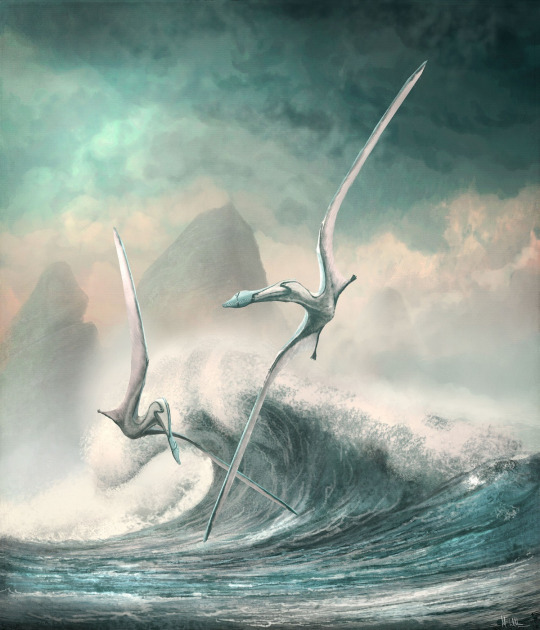
Cimoliopterus by Mark Witton
87 notes
·
View notes
Text
My book! Someone likes my book!
Also this will tell you what the book is really about!
49 notes
·
View notes
Photo
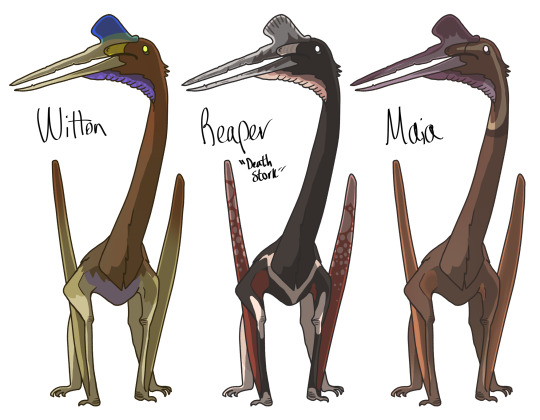
The last of the prehistoric d&d monsters. Because I got lazy and used old art for the Pteranodon, and because I refuse to acknowledge what they did to Hadrosaurus. Nearly bigger than an elephant but with a challenge rating less than a wolf...
Quetzalcoatlus does not suffer from the same fate. In fact, I have nearly killed a player underestimating the damage that beak does. Dramatic lighting seemed fitting because of that.
Reaper is mine, from the one time I've given Quetz a colored drawing. In-game it was referred to as a 'death stork', and was simultaneously sort of bone white and light human skin colored. Witton is based on Dr. Mark Witton's first famous painting of ground-stalking azhdarchids. Maia is from Prehistoric Planet, though I couldn't exactly find good screenshots online to replicate the color scheme exactly.
10 notes
·
View notes
Text
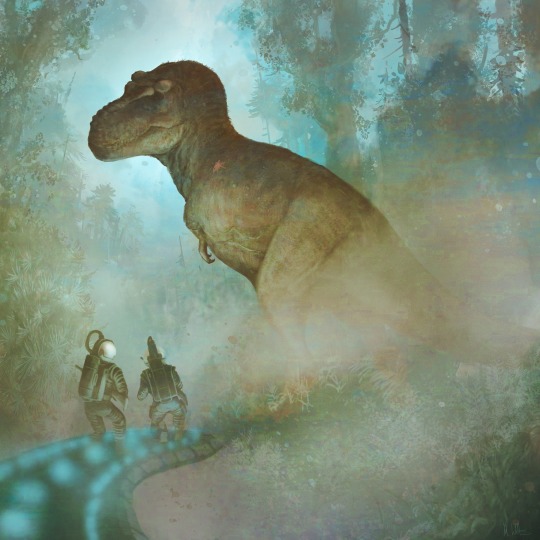
Scene from Ray Bradbury's A Sound of Thunder (1955), illustrated by Mark Witton (2022).
#paeloart#prehistoric life#dinosaurs#tyrannosaurus#mark witton#ray bradbury#time travel#science fiction#into mystery
8 notes
·
View notes
Photo
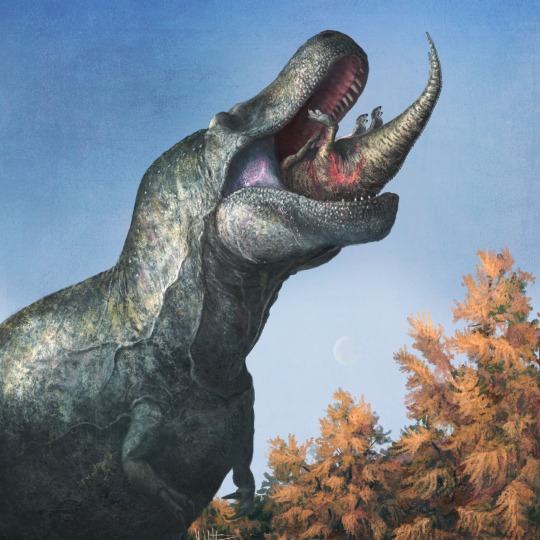
An artist’s concept of a juvenile Edmontosaurus disappearing into the lipped mouth of Tyrannosaurus
Mark P. Witton
603 notes
·
View notes
Text
Dinosaurs are so unreasonably fuck-off huge dude, like this is just excessive
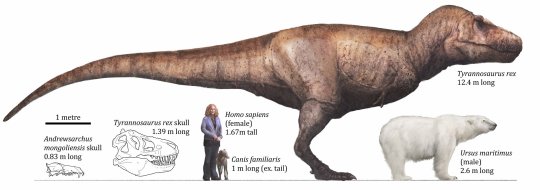
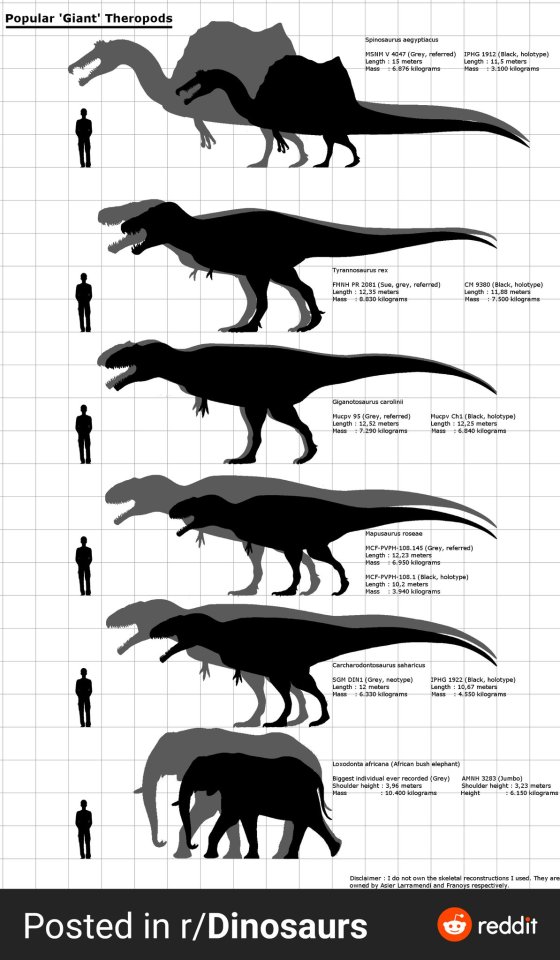
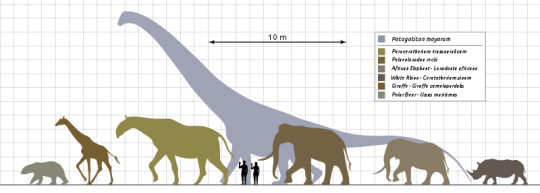
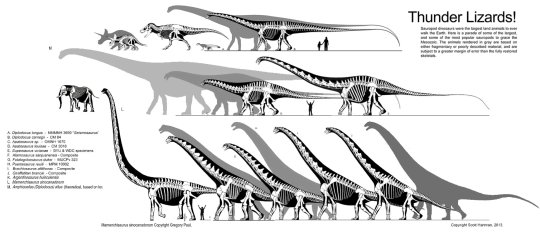
(art by Mark Witton, Franoys, Asier Larramendi, Scott Hartman, GS Paul, and Wikipedia)
2K notes
·
View notes
Note
How accurate is the prehistoric planet Tyrannosaurus rex?
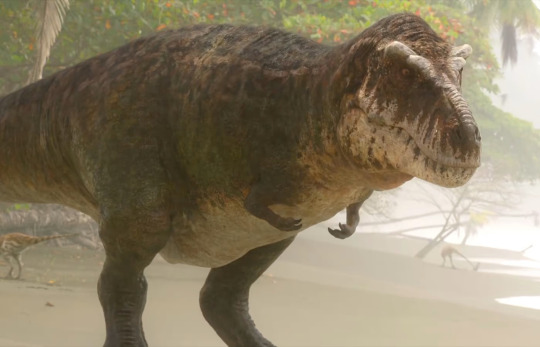
Basically as close to perfect as it's currently possible to get!
"Accuracy" is a bit of a misleading term when it comes to palaeoart, because the inherent uncertainty of reconstructing extinct species means the chances of ever creating a 100% accurate version are basically none.
Some other palaeoartists like Mark Witton and John Conway have supported using the term "credible" rather than "accurate" when talking about palaeoart, which is something I like! "Credible" means the artwork has produced one possible interpretation, sticking as closely to all the scientific evidence out there as possible but leaving room for uncertainty or error.
So the Prehistoric Planet Tyrannosaurus is almost guaranteed to not be 100% accurate to what the real animal looked like. But, given all the available scientific evidence, it is one of the most credible reconstructions out there!

2K notes
·
View notes
Text
2024 Reading Log, pt 2

006. Gardening Can Be Murder by Marta McDowell. I honestly thought that this book was going to be about something else. With the subtitle “how poisonous plants, sinister shovels and grim gardens have inspired mystery writers”, I thought it was going to be about, you know, that. True crime themed to gardens, discussions of poisonous plants, that sort of thing. The book is actually about the mystery books that have gardening as a theme. And while the author’s dedication to not spoiling anything (seriously, anything, even 150 year old stories like The Moonstone or “Rappacini’s Daughter”) is admirable in its own way, this leaves the book feeling like endless buildup without any payoff. Big fans of murder mysteries might enjoy this—especially the last chapter, which interviews writers about their gardens—but I found it more boring than anything else, and finished it only because it was very short.

007. Antimony, Gold and Jupiter’s Wolf by Peter Wothers. This book is about how the elements got their names, and most of it deals with the early modern period, as alchemy transitioned to chemistry and then into the 19th century, when chemistry was a real science, but things like atomic theory were not yet understood. The book goes into fascinating detail, and has a lot of quotes from primary sources, as scientists then were just like scientists now, that is, opinionated and bickering with each other over their preferred explanations. And names! Many of the splits between elements and their symbols (like Na for sodium) are due to compromise attempts to appease two different factions with their preferred names. A book covering arcane minutia of history always has the risk of feeling like a slog, but this is a fast and fun read.

008. Doctor Dhrolin’s Dictionary of Dinosaurs by Nathan T Barling and Michael O’Sullivan, illustrations by Mark P Witton. This book is an odd concept, but one that I was immediately on board with—a D&D book written by paleontologists with the intention of bringing accurate and interesting stats for prehistoric reptiles to the game. The fact that it’s mostly illustrated by Mark Witton definitely clinched my backing that Kickstarter. And this book is a lot of fun. So much so, that I read it all in a single sitting. I don’t know how accurate the stats are (like, a Hatzegopteryx has a higher CR than titanosaurs or T. rexes), but they seem like they’d be fun in play, and the writing does a good job of combining fantasy fun with actual education. Even for someone not running a 5e game, the stuff on how to run animals as not killing machines, and the mutation tables, could be useful. There are multiple types of playable dinosaurs, all of which seem like they’d work well at the table and avoid typical stereotypes, and a lot of in-jokes and pop culture references (like the cursed staff of unspared expense, which looks like Hammond’s cane in the Jurassic Park movie).
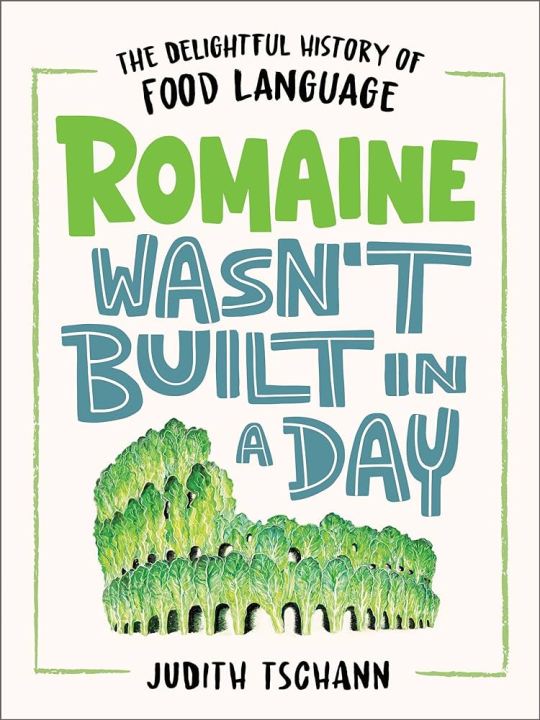
009. Romaine Wasn’t Built in a Day by Judith Tschann. I’m a sucker for books about etymology. And this one, on food etymology, is a pretty breezy read. I had fun with it, and it even busted some misconceptions that I had, etymologically speaking. Like, there’s no evidence that “bloody” as an explicative originated from “God’s blood”? Wild. Etymology books tend to be written in a sort of stream-of-consciousness style, where talking about one word may lead down a garden path to the next one. The book also has a couple of little matching quizzes, which is something I haven’t seen in a book since like the 90s.

010. The Lives of Octopuses and their Relatives by Danna Staaf. I was previously a little disappointed in The Lives of Beetles, another book in this series, but I knew I liked Staaf, who wrote the excellent book Squid Empire about cephalopod evolution and paleontology. I’m pleased to report that this book is also excellent. Staaf takes the “lives” part seriously, and the book is arranged by ecology, looking at different marine habitats, the challenges that they pose to living things, and the cephalopods that live there. Cuttlefish get slightly short shrift in this book compared to squids and octopuses, but that’s about the biggest complaint I had. I like how the species profiles cover more obscure taxa, and information about the best studied (like Pacific giant octopus and Humboldt squid) is kept to the chapters.
#reading log#marine biology#cephalopods#etymology#food history#tabletop rpgs#dinosaurs#D&D 5e#chemistry#periodic table#history of science#mystery#horticulture
74 notes
·
View notes
Note
hi so i’ve been following you for a little (mostly because of dinosaurs and mechanisms) but i’ve been curious about this and don’t really know where else to ask, how do you find dinosaur references? i’ve been wanting to start drawing some dinos again but really have no idea where to go for references or inspiration.
my go-to's are skeletal references and 3d models!
for skeletals, the gold standard is scott hartman's. he's done sooo many and they're all very good- you can find them on his website here. https://www.skeletaldrawing.com/

i do think his life reconstructions tend to be on the shrinkwrapped side, but his skeletals are great.
for skeletals, gregory s. paul is another great resource. if you can find a physical or digital copy of the princeton field guide to dinosaurs, it has skeletal references for a LOOOOT of dinos.
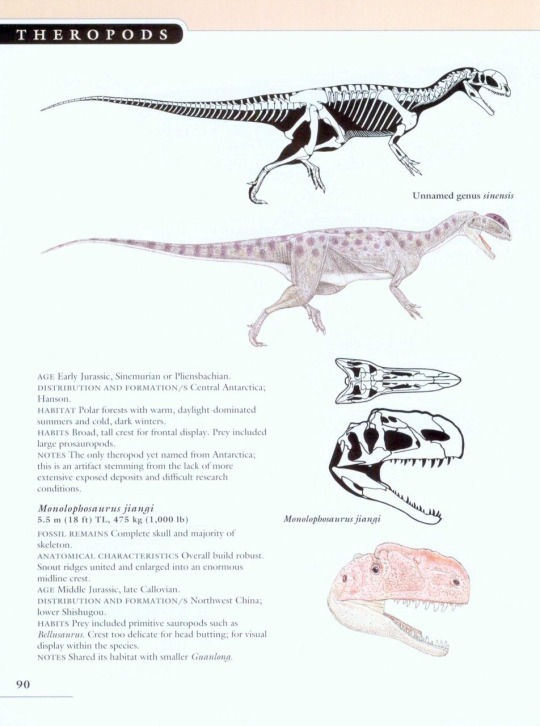
greg paul's life reconstructions should also be taken with a grain of salt- shrinkwrapping and pronated hands abound. his taxonomy is also notably controversial (he's the lead author on that tyrannosaurus regina/rex/imperator paper from a while back..), so double-check the genus/species names you're referencing.
(he also has the princeton field guides to marine reptiles and pterosaurs, but i haven't read those so i can't comment. haven't heard great things about the pterosaurs one, though- if you want pterosaur references, go for pteros.com, pterosaur.net, and mark witton's "pterosaurs" book)
now for 3d models- skeletals are all well and good, but if you're not drawing a dinosaur from the side their usefulness can be limited. sketchfab is my go-to to find 3d reference. i look for skeletons/skulls from museums that have been digitized, mostly-

but i'll also look for full reconstructions, just reference them in the same way you'd reference any other art piece (with care).
i also sometimes use the video games saurian and prehistoric kingdom? they both allow you to spin around the models of their animals, and their reconstructions are both super good.
lastly is to reference the work of other palaeoartists! this especially fits in for the inspiration part.
here's a few awesome palaeoartists around the internet (tyhank you to billymayslesbian for helping me put these together!)
mark witton

fred wierum (aka fredthedinosaurman)
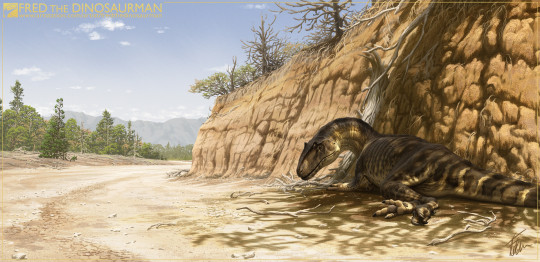
john conway

alphynix (here on tumblr under the same name)
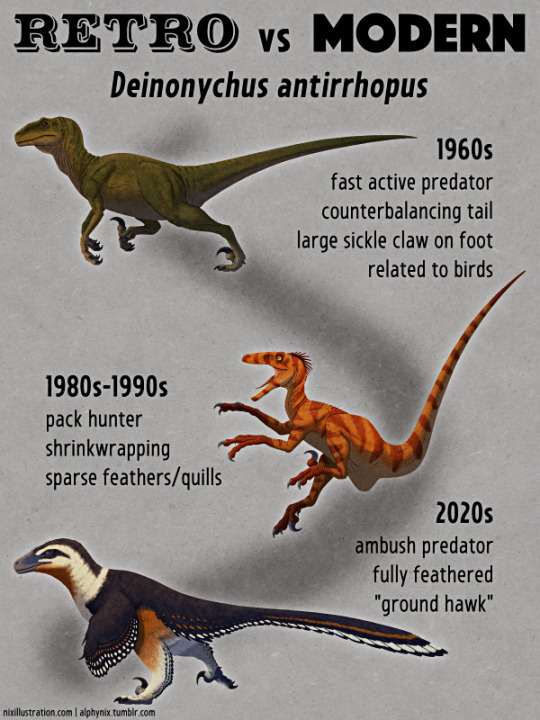
julio lacerda (this hatzegopteryx image is one of my favorite palaeoarts ever tbh)

joschua knüppe (here on tumblr at knuppitalism-with-ue, i'm especially a fan of his work recreating classical paintings with extinct primates)

and for more cartoony/styilized work:
miquel camiodraws
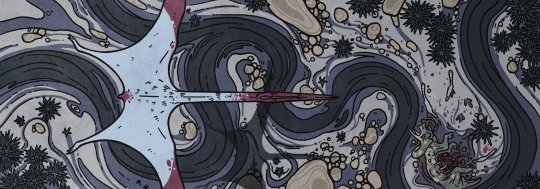
johan egerkrans

abby howard (here on tumblr at abby-howard)

natalia jagielska

greer stothers (here on tumblr at pangur-and-grim)
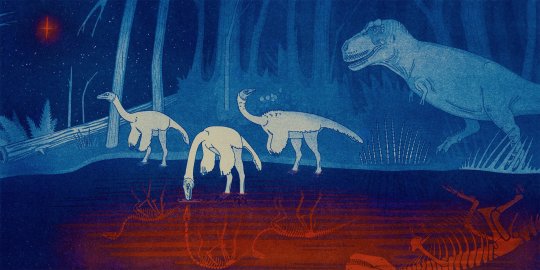
nev (saint-nevermore here on tumblr, this picture is one of my favorite palaeoarts of all time)

for some more books, check out all yesterdays by darren naish and john conway, which takes a highly speculative look at reconstructions of prehistoric animals, mostly dinosaurs.
also look at mark witton's the palaeoartist's handbook, which is exactly what it sounds like and i think could be VERY helpful for what you're looking for.
61 notes
·
View notes
Text

IT'S COMING HOME!
I have painstakingly reconstructed Benjamin Waterhouse Hawkins' Palaeotherium magnum sculpture. Lost decades ago, join us (Ellinor Michel, Mark Witton, Friends of Crystal Palace Dinosaurs) this Sunday to see its return.
More here: https://www.londonfestivalofarchitecture.org/event/beyond-the-dinosaurs-a-series-of-tours/
#Art#Painting#PaleoArt#PalaeoArt#SciArt#SciCom#DigitalArt#Illustration#Dinosaurs#Birds#Reptiles#Palaeontology#Paleontology#paleo#clay sculpting
287 notes
·
View notes
Note
Not sure if this is the sort of question that you are expecting, but I am wondering if you have any book recommendations on dinosaurs? I do have a few books that seem to provide excellent information, but I am wondering if you can recommend more books like Princeton's Field Guide to Dinosaurs, etc?
ewwww greg paul. stop reading greg paul
anything by Darren Naish
anything by Mark Witton
anything by Michael Benton
anything by Thomas Holtz
the new Evan Johnson-Ransom book
anything that involves Julius Csotonyi
Gerald Mayr is the go-to for Cenozoic dinos
yes I wish this list wasn't almost all white men
264 notes
·
View notes
Text
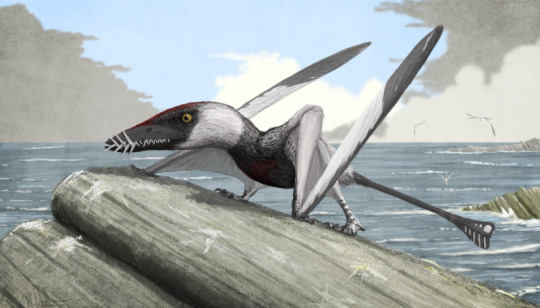
Life restoration of the Early Jurassic rhamphorhynchine pterosaur, Dorygnathus banthensis, with obligated crouching, somewhat sprawled forelimbs
illustration by Mark P. Witton
https://peerj.com/articles/1018
65 notes
·
View notes
Text
On pterosaur footprints

A maker of Rhamphichnus footprints by Mark Witton. Note pronated arms.
There are three main pterosaur ichnotaxa (footprints assigned taxonomically):
Pteraichnus is by far the most common, occuring from the Jurassic to the very end of the Cretaceous, and can be considered a bit of a wastebasket taxon, though it’s well distinguished by lateral three-fingered foreprints and large hindprints.
Haenamichnus are Maastrichtian tracks assigned specifically to azhdarchids. These are very large in size and differ from Pteraichnus by having more compact footprints, with digits barely differentiated.
Rhamphichnus are tracks made by non-pterodactyloid pterosaurs. They differ from the rest in having pronated forelimbs and more square-shaped hindprints with longer toes.
These foot prints offer quite a lot about pterosaur palaeobiology. Haenamichnus validates the notion that azhdarchids had compact feet and were specialised to hunt in terrestrial environments, while Rhamphichnus shows that early pterosaurs could rotate their forelimbs like mammals can. But the ones I find most interesting are the ‘generic’ Pteraichnus. While as mentioned above they might be a bit of a wastebasket, they are typically assumed to be made by ctenochasmatoids or dsungaripteroids (Witton 2013). Since they last until the end of the Cretaceous, this could indicate the presence of these pterosaurs well past the end of their fossils.
This has precedent, as Pteraichnus attributed to dsungaripteroids have been found in Late Cretaceous deposits, tens of millions of years after the closest footprint makers disappear from the fossil reccord. Therefore, they indicate long fossil ghost lineages.
Hopefully, more studies will be conducted on pterosaur footprints.
80 notes
·
View notes
Text

Once a living god of the skies...
A young T. rex comes face to face with an adult Quetzalcoatlus
Art by Mark Witton
#paleontology#dinosaurs#paleoart#art#natural history#science#paleontología#dinosaur#ciencia#quetzalcoatlus#jurassic world#Jurassic world dominion#pterosaur
2K notes
·
View notes
Text
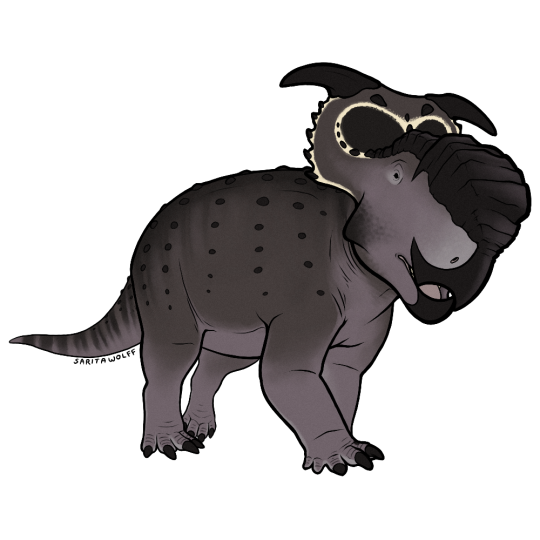
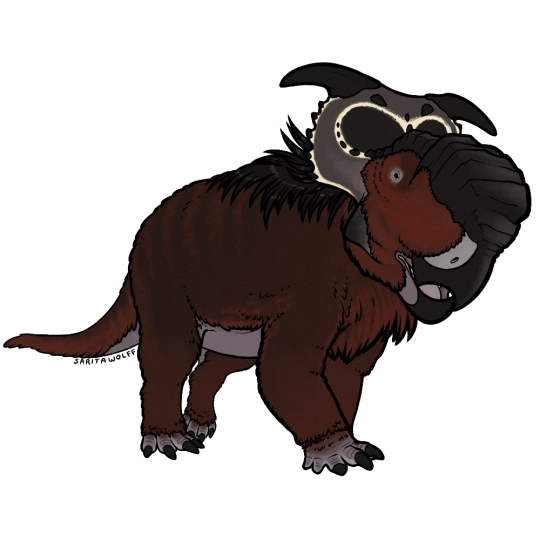
A Patreon request for rome.and.stuff (Instagram) - Pachyrhinosaurus perotorum… that I went a bit overboard with lol. I’ve been waiting for an excuse to draw my favorite ceratopsian, and to digitally adapt my old Pachy marker drawing design.
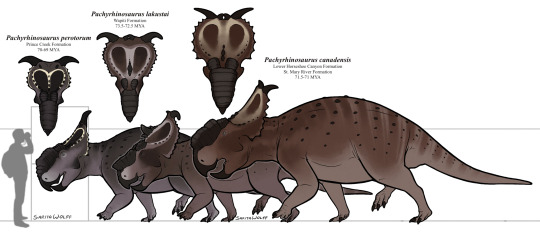
So! Pachyrhinosaurus! As seen above, there were three known species of Pachyrhinosaurus, living in different locations and eras in Late Cretaceous North America.
The oldest, P. lakustai, was native to the Wapiti Formation of Alberta and British Columbia, Canada. It’s known for the extra spikes it has at the center of its frill.
The slightly younger P. canadensis was native to the lower Horseshoe Canyon Formation and the St. Mary River Formation of Alberta and northwestern Montana. It was the largest of the three.
The youngest, P. perotorum, was native to the Prince Creek Formation of Alaska. As this ceratopsid seemingly stayed put during the long, dark, cold Alaskan Winters, it likely had adaptations for keeping warm.

The depiction of a “woolly” Pachyrhinosaurus was first popularized by Mark Witton as a speculative work, but the trope has prevailed. While many paleontologists find a heavy feather covering on a centrosaurine to be highly unlikely, and maintain that the animal’s size and homeothermy would have kept it warm enough, we still have no skin impressions to suggest that P. perotorum was fully scaly. So a feather coating is not completely out of the question (though it is unlikely). Still, I love the look of a woolly Pachyrhinosaurus and how it challenges our previous conceptions of non-avian dinosaurs. Stranger things exist in nature. I had to include a “woolly” option, especially since I already use the guy as my avatar on my paleo Instagram account, SaritaPaleo.
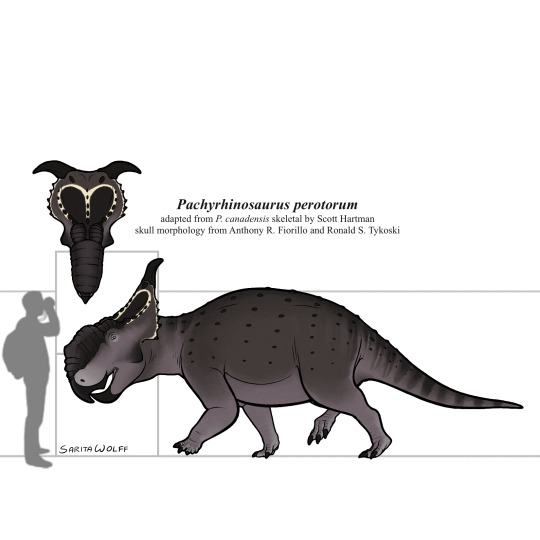
Pachyrhinosaurus was particularly unique in that it seemingly traded off something that had previously worked for other ceratopsians, horns, for a large nasal boss instead. For Pachyrhinosaurus, a battering ram worked better than a sword.
It was herbivorous, using its strong cheek teeth to chew tough, fibrous plants. Perhaps during the dark and cold Winters, P. perotorum would have also dug for roots or even scavenged carcasses. At any rate, from observations of their unusually conspicuous growth banding, it appears growth for P. perotorum would have been stunted during the harsh Winter, but was extremely rapid in the warmer months, an adaptation for the Alaskan climate.
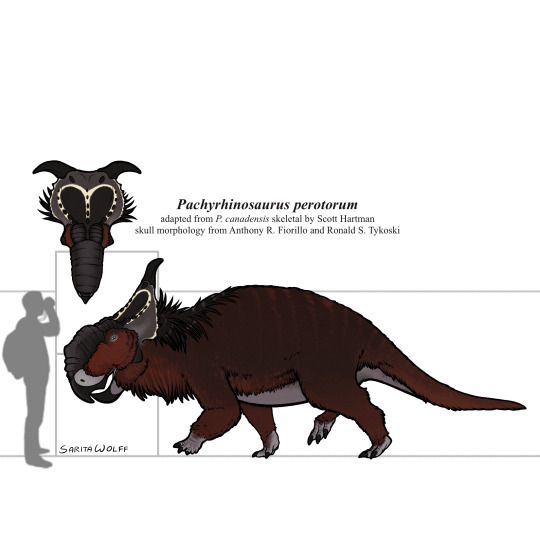
The tundra of the Prince Creek Formation housed a surprising amount of diversity. Pachyrhinosaurus perotorum would have lived alongside smaller ceratopsians like Leptoceratopsids, as well as other ornithischians like the pachycephalosaurine Alaskacephale and the hadrosaurid Edmontosaurus. Theropods such as Dromaeosaurus and Saurornitholestes, as well as a yet unidentified giant Troodontid, lived here as well. P. perotorum’s main predator would have been the tyrannosaur Nanuqsaurus. Small mammals were also somewhat common here, such as Cimolodon, Gypsonictops, Sikuomys, Unnuakomys, and an indeterminate marsupial.
(Btw, the request tier for Patreon starts at only $5 a month. 😉 Link is pinned at the top of my blog.)
#my art#SaritaDrawsPalaeo#Pachyrhinosaurus#Pachyrhinosaurus perotorum#Pachyrhinosaurus lakustai#Pachyrhinosaurus canadensis#Centrosaurines#ceratopsians#ceratopsids#ornithischians#dinosaurs#archosaurs#archosauromorphs#reptiles#Prince Creek Formation#Wapiti Formation#Horseshoe Canyon Formation#St. Mary River Formation#Late Cretaceous#Canada#United States of America
80 notes
·
View notes